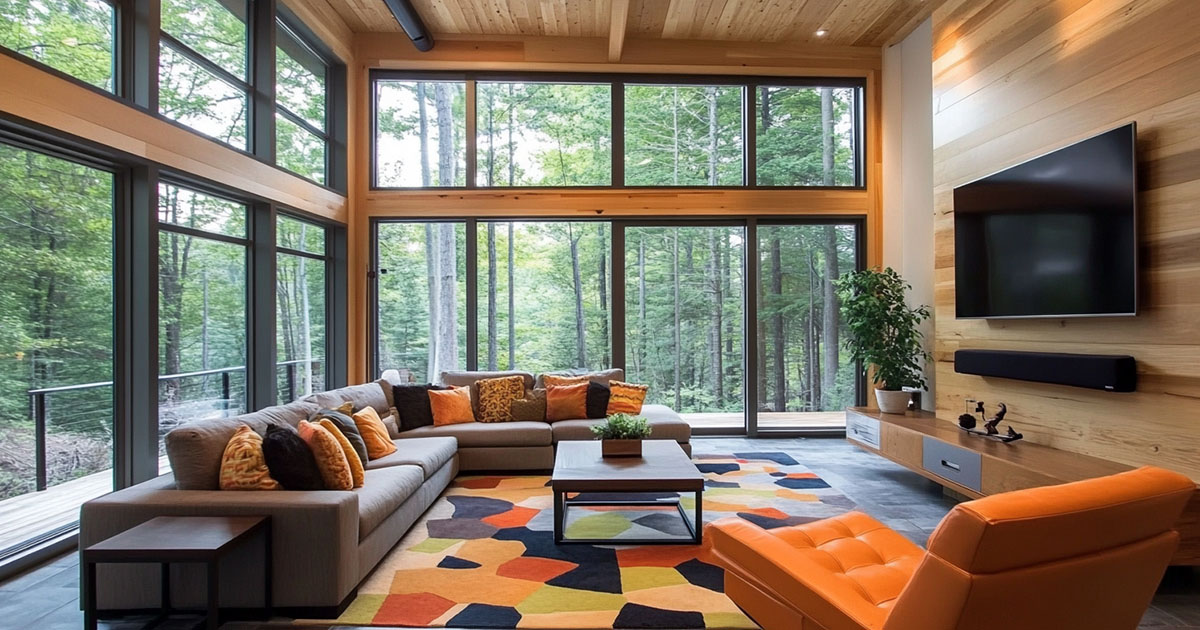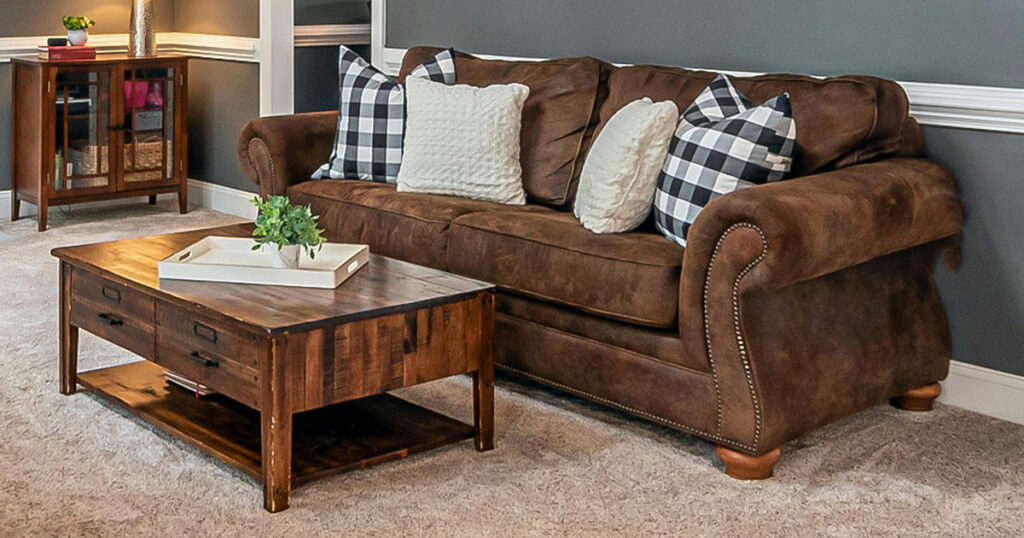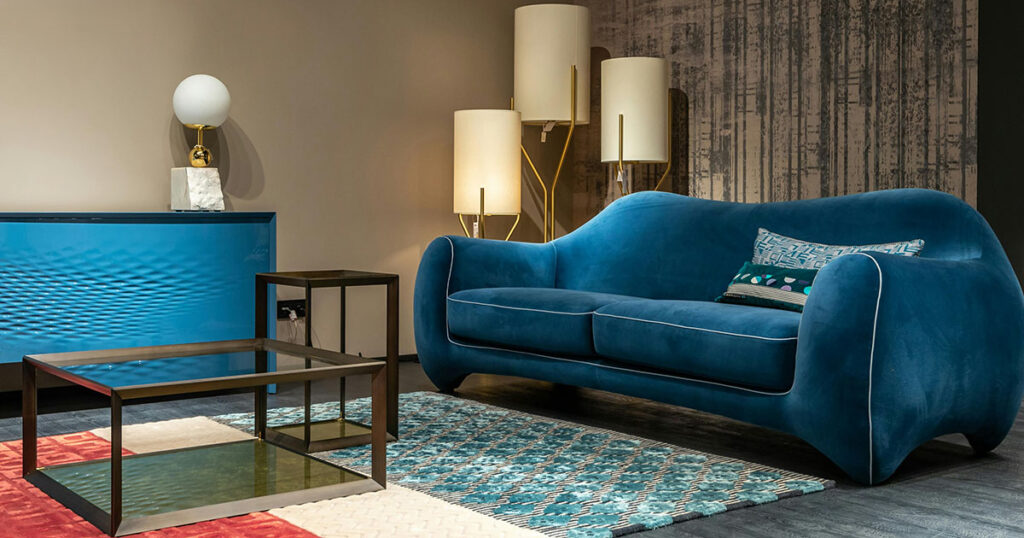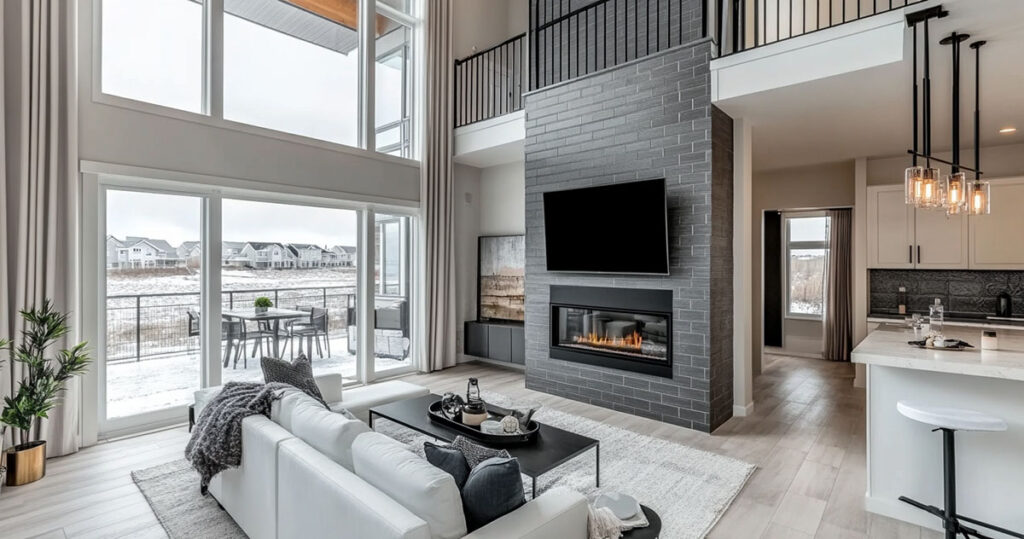Finding the right rug for a mid-century modern space is like finding the perfect album cover for a classic vinyl record—it needs to complement the music while making a statement of its own.
Mid-century modern style captivates with its clean lines, organic forms, and thoughtful simplicity. The right rug can tie these elements together beautifully, becoming the unsung hero of your interior design.
Whether you’re furnishing a cozy home living room or designing a stylish commercial space, this guide will walk you through everything you need to know about selecting rugs that enhance mid-century aesthetics.
Understanding Mid-Century Modern Style Foundations
Key Characteristics of Mid-Century Interiors
Mid-century modern design (popular from the 1940s to 1960s) embraces clean lines and minimal ornamentation. Rooms have an uncluttered look where every piece serves a purpose. The style blends strict geometric forms with gentle organic curves to create visual interest and balance.
Natural materials play a starring role, with wood tones often serving as centerpieces. Teak, walnut, oak, and rosewood appear frequently in furniture pieces, adding warmth and texture. These natural elements contrast beautifully with industrial touches like metal and glass.
Open, airy spaces define mid-century architecture. Rather than enclosed rooms, spaces flow into each other, creating casual, social atmospheres. Large windows bring the outdoors in, emphasizing natural light and connections to nature.
Iconic furniture with slim profiles and sculptural forms complete the look. Pieces typically have tapered legs with a low, horizontal emphasis that keeps sight lines open. Understanding these fundamentals helps ensure your rug selection complements rather than competes with these distinctive elements.
Color Palettes in Mid-Century Design
The mid-century palette typically combines neutral or earthy base tones with vibrant accent colors. This approach—warm neutrals punctuated by bold, retro shades—creates a lively yet balanced look.
Certain colors have become synonymous with mid-century style. Mustard yellow, olive green, burnt orange, and deep teal blue particularly evoke the era. These colors appear in both vibrant and muted forms, often in accent pieces like upholstery, art, and rugs.
When selecting a rug color, consider whether you want it to blend in or stand out:
- Neutral foundation rugs (beige, cream, gray, or brown) allow furniture and accents to shine, creating a cohesive, calming base.
- Earth tones (olive green, rust, terra cotta, golden yellow) feel period-appropriate and create a harmonious ambiance.
- Bold accent rugs in signature mid-century colors can energize the space and serve as focal points that tie the room together.
Aim for a balanced palette.
If your rug carries a strong color, keep other large surfaces neutral to maintain the classic mid-century balance of “neutral background with bold accents.”
Patterns and Motifs for Mid-Century Rugs
Geometric and Abstract Designs
Geometric patterns are hallmarks of mid-century decor. Repeating shapes like rectangles, diamonds, circles, or triangles instantly create a retro atmosphere. “Atomic” age patterns—starbursts, boomerangs, molecular motifs—reference the space-age inspiration of the era.
Rugs with interlocking geometric forms or bold repeats work perfectly in mid-century spaces. Clean-lined, graphic patterns reflect the era’s love of abstraction without appearing fussy or overly ornate.
The key is selecting patterns that feel purposeful and graphic rather than random or intricate. Simple forms rendered boldly create that signature mid-century vibe.
Organic and Free-Form Motifs
Alongside geometry, mid-century style embraces organic shapes and curvilinear forms. This natural influence appears in rugs through abstract organic motifs—curved lines, leaf-like shapes, or amoeba forms that meander across the surface.
Classic mid-century shapes like the kidney bean (familiar from coffee tables of the era) work beautifully in rug patterns. Free-form designs with sweeping lines or irregular shapes add artistic character and softness that balances the harder lines of mid-century furniture.
These organic patterns bring movement and flow to a space, complementing the sculptural furniture typically found in mid-century rooms.
Balancing Pattern Scale and Visual Weight
When choosing a pattern, consider scale and visual weight. Mid-century patterns can be bold, but designers of the era carefully balanced them with plain areas for visual rest.
If you opt for a loud, multicolored geometric rug, ensure nearby elements (sofa upholstery, wall color) remain subdued to let the rug shine. Conversely, if your furniture or art features strong patterns, choose a rug with a more subtle design to prevent visual competition.
The goal is a balanced room where patterns add interest without creating chaos. A good approach is to echo shapes: if your furniture features many straight lines, a rug with circular patterns can introduce pleasing contrast; if curved forms dominate the room, a rug with a crisp geometric repeat adds structure.
Size, Shape, and Placement
Defining Space with Rug Placement
Mid-century homes often feature open layouts where distinct functional areas flow together. Rugs help delineate these zones, creating “rooms within rooms.” A rug under a seating group instantly establishes that area as a cohesive conversation space.
For best results, place living room rugs centered under coffee tables, extending far enough that at least the front legs of sofas and chairs rest on them. This ties the furniture grouping together visually.
In dining areas, ensure rugs extend at least 24-30 inches beyond the table so chairs remain on the rug even when pulled out. This creates both a functional and aesthetically pleasing arrangement.
Choosing the Right Size and Shape
Size matters tremendously in rug selection. A rug that’s too small will float awkwardly and make the space feel disjointed; one that’s too large might overwhelm the room.
In mid-century interiors, which value proportion and balance, aim for a rug size that anchors the furniture without dominating. Ideally, leave a border of bare floor around the perimeter—mid-century rooms typically featured beautiful hardwood or tile floors that deserve to be showcased.
While rectangular rugs dominate the market, mid-century modern style gives license to explore other shapes. Round rugs soften angular spaces and echo circular elements like tulip tables or spherical light fixtures. Free-form or asymmetrical shapes make particularly striking statements in mid-century contexts, referencing the organic-meets-geometric tension that defines the style.
Custom Rug Design Options for Mid-Century Aesthetics
Color Blocking and Sectional Designs
Mid-century modern art often employed color blocking—large areas of solid color juxtaposed for bold effect. This approach translates beautifully to rug design. Consider a custom rug with blocks or zones of different colors, perhaps meeting in a diagonal line or creating geometric sections.
Color blocked rugs instantly evoke a retro feel while remaining simple and striking. A rug that is mostly neutral with strategic pops of color in geometric shapes feels quintessentially mid-century without overwhelming the space.
When planning such a design, use authentic mid-century colors as your palette, and consider how the color transitions might align with furniture placement for a thoughtful, integrated look.
Playing with Pile Height and Texture
Custom tufted rugs offer exciting possibilities for texture play through varying pile heights. This technique creates visual and tactile interest without adding more colors to the space.
Consider a rug with high-low pile—some areas tufted higher in cut pile and others in lower loop pile—to create subtle patterns through texture alone. The design might only become fully visible up close or when light strikes at certain angles, adding sophisticated detail.
This approach works particularly well with mid-century motifs because it can mimic relief sculpture or architectural elements of the era. The texture adds dimension without busyness, perfect for mid-century’s balanced approach.
Custom Shapes and Borders
With custom manufacturing, you’re not limited to standard rectangles. A kidney bean-shaped rug could perfectly complement a curved sofa, while a hexagonal or circular rug with a distinctive border might better suit a particular architectural feature.
Border treatments offer another customization opportunity. Consider a rug with a contrasting color border that picks up an accent from elsewhere in the room, or a border in a different pile height or texture for subtle distinction.
These unique shapes and treatments help your rug become not just a floor covering but a conversation piece that reinforces the mid-century aesthetic.
Creating Visual Harmony: Rugs and Mid-Century Furniture
Complementing Iconic Furniture
Mid-century furniture often features strong, sculptural shapes. Your rug should complement these pieces rather than competing with them. If you have an iconic designer chair or distinctive sofa, consider a rug that enhances rather than overpowers it.
One effective strategy is to echo colors or forms from your furniture in the rug design. If your coffee table has an oval shape, perhaps the rug’s pattern incorporates some curved lines. If your furniture features warm walnut wood, a rug that includes complementary brown tones will create immediate harmony.
This intentional mirroring creates a dialogue between the rug and furnishings, making the space feel cohesive and thoughtfully designed.
Balancing Textures and Visual Weight
Visual balance extends beyond pattern and color to texture. Mid-century interiors typically mix materials—smooth wood, shiny metal, soft upholstery. Your rug adds another textural element to this mix.
If most of your furniture consists of hard materials, a plush, tufted rug adds welcome softness. The pile height influences the rug’s visual weight: a thick, shaggy rug draws the eye downward and creates a casual, cozy presence, while a flatter, low-pile rug provides a cleaner, more polished look.
Consider also the visibility of furniture legs. Mid-century pieces often feature distinctive tapered legs that raise furniture off the floor. This means much of your rug will be visible beneath and around pieces. Ensure patterns extend throughout the rug rather than concentrating only in areas that might be covered by furniture.
Tailoring Approaches for Different Settings
Residential Mid-Century Interiors
Home settings allow for more personal expression and comfort-driven choices. In residential spaces, you have freedom to select rugs that truly reflect your personality while staying within the mid-century framework.
Don’t hesitate to incorporate your favorite colors or playful patterns—your living room is the perfect canvas for these personal touches. You might choose a conversation-piece rug with a distinctive motif you love, as homes can accommodate more adventurous designs than public spaces.
Comfort matters too. A mid-century living room rug might be plusher to encourage lounging and create a warm atmosphere. Even though mid-century design is streamlined, mid-century homes were still homes—places for relaxation and living. A slightly shaggy rug or a thick-pile design can amplify that cozy, retro vibe.
Commercial Mid-Century Spaces
In commercial environments like offices, hotels, or retail shops, mid-century modern design creates a stylish, inviting ambiance that supports the brand identity. Rug selection in these contexts often follows slightly different priorities.
Commercial spaces typically need to appeal to a broader audience, so rug colors and patterns might be more controlled—perhaps limited to two main colors plus neutrals that align with the overall interior branding. Classic mid-century colors and patterns with broad nostalgic appeal often work better than highly experimental designs.
Scale also differs. Commercial spaces are usually larger and viewed from greater distances, making larger-scale patterns more effective. A hotel lobby might benefit from a bold, oversize pattern that would overwhelm a home living room.
Visual cohesion becomes especially important in commercial settings. If multiple rugs appear throughout an area, they should share a consistent theme—perhaps all featuring variations on a geometric pattern in a coordinated color palette.
Mixing Retro and Contemporary Elements
Creating a Fresh Mid-Century Look
Today’s mid-century inspired interiors rarely aim to recreate period-perfect time capsules. Instead, they blend retro and contemporary elements for spaces that feel both nostalgic and fresh.
One effective blending strategy is using rugs that feature mid-century patterns rendered in modern ways. For instance, a classic geometric pattern in a contemporary color scheme (like black and white) bridges eras. Alternatively, use very current abstract designs executed in authentic mid-century colors like avocado green and mustard yellow.
Another approach involves balancing bold vintage pieces with sleeker, more minimal elements. If your rug makes a strong retro statement with pattern or color, pair it with simpler, more contemporary furniture. Conversely, a subtle, understated rug can ground more distinctive mid-century furniture without competing for attention.
This balanced mixing creates spaces that honor mid-century aesthetics without feeling frozen in time—they evolve and breathe with contemporary influence.
Personalizing Your Mid-Century Space
The most successful mid-century inspired interiors feel personal rather than formulaic. Your rug offers an opportunity to infuse your individual style while maintaining mid-century foundations.
Perhaps you love another design style alongside mid-century—like Scandinavian, bohemian, or industrial.
Your rug can subtly incorporate elements from these aesthetics while remaining compatible with mid-century principles.
For example, a simple geometric pattern in neutral white/black feels Scandinavian yet works beautifully with mid-century teak furniture.
The goal is a space that feels like “you”—curated and non-cliché rather than copied from a design magazine.
Keep mid-century as the dominant foundation, but don’t be afraid to introduce touches that reflect your personal taste.
Practical Tips for Picking Rugs
When selecting a rug for your mid-century space, remember these key principles:
- Choose colors from the mid-century palette: neutrals, earth tones, and signature accent colors like mustard, teal, orange, and olive green.
- Select patterns that reflect mid-century style: geometric designs, atomic age motifs, or organic free-form shapes.
- Size your rug to anchor furniture groups while leaving some floor visible around the edges.
- Balance bold patterns with quieter surrounding elements—if the rug is a statement piece, let other elements support rather than compete.
- Consider how pile height and texture contribute to the overall feel of the space.
- In custom rugs, explore options like color blocking, varying pile heights, and unique shapes that reinforce mid-century themes.
By thoughtfully applying these principles, you’ll select a rug that not only complements your mid-century interior but elevates it.
You can create a space that honors this beloved design era while meeting your contemporary needs.




